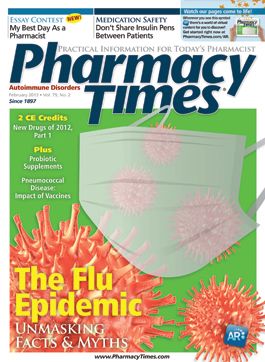Publication
Article
Pharmacy Times
Pfizer, Inc's Xeljanz
Author(s):
Xeljanz (tofacitnib) tablets are indicated for adults with moderately to severely active rheumatoid arthritis who have failed methotrexate.
Xeljanz (tofacitnib) tablets are indicated for adults with moderately to severely active rheumatoid arthritis who have failed methotrexate.
The FDA approved Pfizer’s Xeljanz (tofacitinib) tablets for the treatment of adults with moderately to severely active rheumatoid arthritis (RA) who have had an inadequate response or intolerance to methotrexate. It may be used either as monotherapy or in combination with methotrexate or other nonbiologic disease-modifying antirheumatic drugs (DMARDs); however, it should not be used in combination with biologic DMARDs or with potent immunosuppressants such as azathioprine and cyclosporine.1
Xeljanz is the first agent in its class to receive FDA approval, and the first oral DMARD to be approved for RA in 10 years.2 The approval for Xeljanz includes a boxed warning and a Risk Evaluation and Mitigation Strategy.1,3
Pharmacology and Pharmacokinetics
Xeljanz is a Janus kinase (JAK) inhibitor. It exerts its effect by modulating the signaling pathway at the point of JAKs, thus preventing phosphorylation and activation of Signal Transducers and Activators of Transcription, which modulate intracellular activity, including gene expression.
After an oral dose of Xeljanz, peak plasma concentrations are reached within 0.5 to 1 hour. Elimination half-life is approximately 3 hours, and a dose-proportional increase in systemic exposure was observed in the therapeutic dose range. Steady state concentrations are achieved in 24 to 48 hours.1
Dosage and Administration
Xeljanz should be given as 5 mg orally twice a day without regard to food. No dose adjustment is needed for patients with mild hepatic or renal impairment. Patients with moderate hepatic impairment or moderate to severe renal impairment should receive 5 mg orally once a day. Xeljanz has not been studied in patients with severe hepatic impairment, those who are positive for hepatitis B or hepatitis C, or for patients with a baseline creatinine clearance less than 40 mL/min. Dose interruption may be required if lymphopenia occurs.1
Clinical Trials
Xeljanz was studied in 7 clinical trials of adults with moderately to severely active RA.3 Xeljanz was studied in doses of both 5 mg twice daily and 10 mg twice daily. The FDA approved the 5-mg twice-daily dose and requested further data to assess the benefit-to-risk profile of the 10-mg dose.2 In all trials, patients using Xeljanz demonstrated an improvement in clinical response and physical function compared with patients receiving placebo.3
Warnings and Precautions
Xeljanz carries a boxed warning regarding the increased risk for serious infections, such as active tuberculosis, invasive fungal infections, and other opportunistic infections. Patients should be tested for latent tuberculosis before beginning treatment with Xeljanz and monitored for the development of infections during treatment with Xeljanz, including those patients who tested negative for latent tuberculosis prior to treatment.
The boxed warning also states that lymphoma and other malignancies have been observed in patients using Xeljanz. Epstein—Barr virus–associated post-transplant lymphoproliferative disorder has been observed at a higher rate in renal transplant patients who are using Xeljanz concurrently with other immunosuppressive medications.
There are no contraindications to treatment with Xeljanz.
Xeljanz should not be given during an active infection, including localized infections. If an infection occurs, Xeljanz should be interrupted. Use Xeljanz cautiously in patients at increased risk for gastrointestinal perforations. Changes in lymphocytes, neutrophils, hemoglobin, liver enzymes, and lipids may occur and laboratory monitoring is recommended. Patients using Xeljanz should not receive live vaccinations. Xeljanz should not be used in patients with severe hepatic impairment.
Xeljanz is Pregnancy Category C and should only be used during pregnancy if the benefit outweighs the risk. Xeljanz should not be used while breast-feeding.
When Xeljanz is used concomitantly with potent inhibitors of cytochrome P450 (CYP) 3A4 or with 1 or more medications that result in both moderate inhibition of CYP3A4 and potent inhibition of CYP2C19, the dose should be reduced to 5 mg once daily. Clinical response may be lost or reduced when Xeljanz is used in combination with potent CYP inducers, such as rifampin.
The most commonly reported adverse reactions (≥2%) were upper respiratory tract infections, headache, diarrhea, and nasopharyngitis.1
Dr. Holmberg earned her PharmD from the University of Connecticut and completed an ambulatory care residency at the Phoenix VA Healthcare System. Her practice has also included pediatrics and inpatient mental health. She resides in Phoenix, AZ.
References:
- Xeljanz complete prescribing information. http://labeling.pfizer.com/ShowLabeling.aspx?id=959. Accessed November 2012.
- U.S. Food And Drug Administration approves Pfizer’s XELJANZ (tofacitinib citrate) for adults with moderately to severely active rheumatoid arthritis (RA) who have had an inadequate response or intolerance to methotrexate. www.pfizer.com/news/press_releases/pfizer_press_release.jsp?guid=2653 at http://pfizer.newshq.businesswire.com&source=2012&page=1. Accessed November 2012.
- FDA approves Xeljanz for rheumatoid arthritis. www.fda.gov/NewsEvents/Newsroom/PressAnnouncements/ucm327152.htm. Accessed November 2012.







